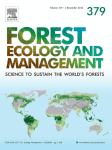Ver ítem
- xmlui.general.dspace_homeCentros Regionales y EEAsCentro Regional Patagonia SurEEA EsquelArtículos científicosxmlui.ArtifactBrowser.ItemViewer.trail
- Inicio
- Centros Regionales y EEAs
- Centro Regional Patagonia Sur
- EEA Esquel
- Artículos científicos
- Ver ítem
Role of abiotic factors in nothofagus pumilio forest mortality: the sensitivity of ecotones
Resumen
The world's forests are being affected by a changing climate. Recently, patches of dead trees have been found in forests of the Patagonian endemic species Nothofagus pumilio, which could not be related to insects or pathogenic fungi acting as primary agents. This study aimed to analyze environmental variables associated with N. pumilio mortality at a landscape scale. Dead patches were recorded from satellite image analysis and field trips throughout the
[ver mas...]
The world's forests are being affected by a changing climate. Recently, patches of dead trees have been found in forests of the Patagonian endemic species Nothofagus pumilio, which could not be related to insects or pathogenic fungi acting as primary agents. This study aimed to analyze environmental variables associated with N. pumilio mortality at a landscape scale. Dead patches were recorded from satellite image analysis and field trips throughout the distribution of N. pumilio forests in Chubut province (Argentina). The relation between forest mortality and environmental variables, including elevation, slope, aspect, recent volcanic ash deposits, precipitation, and temperature, was analyzed by contingency tables and chi-square analysis, and a risk model was developed using the Maximum Entropy (MaxEnt) algorithm. One hundred and seven dead patches were recorded only in the northern region of the study area (ca. −42.5°S to −44.5°S), where forests develop at higher elevations, slopes, precipitations, and temperatures than in the southern region. In the northern region, elevation, followed by precipitation, was the environmental variable most related to forest mortality. Nothofagus pumilio mortality was related to two ecotones: an altitudinal one, associated with middle-high mountainsides (1200 and 1400 m asl), and a longitudinal one, associated with intermediate values of mean annual precipitation within the west-east rainfall gradient. These results highlight the sensitivity of these transitional environments. According to the risk model based on abiotic features, more than 100,000 ha of forest (ca. 30%) are located under environmental variables favorable for decline and death. In the context of climate change and in the light of the results, abiotic factors seem to be the main predisposing factors of N. pumilio mortality.
[Cerrar]

Autor
Tarabini, Manuela;
Gomez, Federico Antonio;
Calderón, Miguel Ángel;
La Manna, Ludmila;
Fuente
Forest ecology and management 494 : 119316. (August 2021)
Fecha
2021-04-24
Editorial
Elsevier
ISSN
0378-1127
Formato
pdf
Tipo de documento
artículo
Palabras Claves
Derechos de acceso
Restringido
 Excepto donde se diga explicitamente, este item se publica bajo la siguiente descripción: Creative Commons Attribution-NonCommercial-ShareAlike 2.5 Unported (CC BY-NC-SA 2.5)
Excepto donde se diga explicitamente, este item se publica bajo la siguiente descripción: Creative Commons Attribution-NonCommercial-ShareAlike 2.5 Unported (CC BY-NC-SA 2.5)

